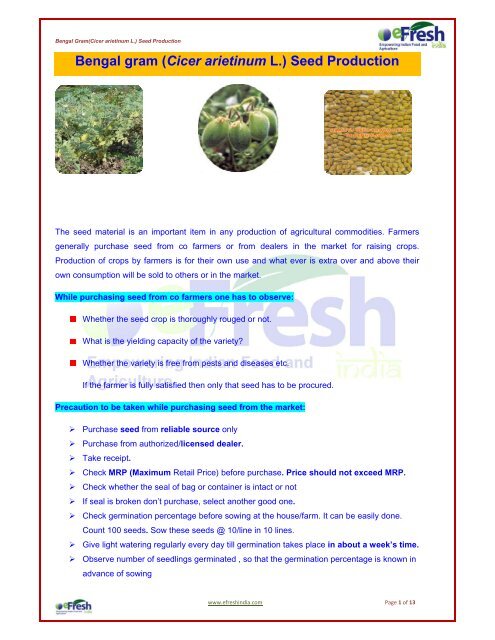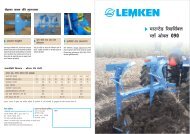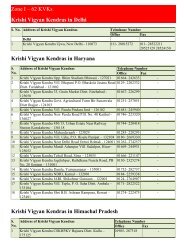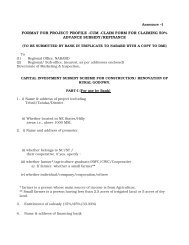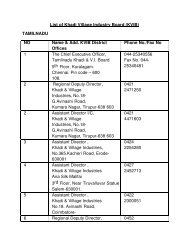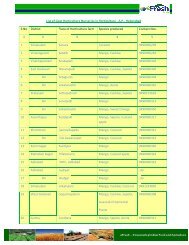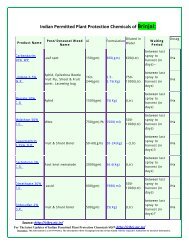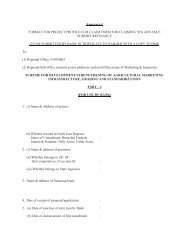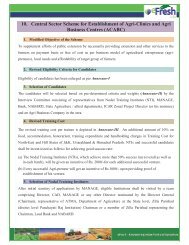Bengal gram (Cicer arietinum L.) Seed Production - Efresh India
Bengal gram (Cicer arietinum L.) Seed Production - Efresh India
Bengal gram (Cicer arietinum L.) Seed Production - Efresh India
Create successful ePaper yourself
Turn your PDF publications into a flip-book with our unique Google optimized e-Paper software.
<strong>Bengal</strong> Gram(<strong>Cicer</strong> <strong>arietinum</strong> L.) <strong>Seed</strong> <strong>Production</strong><br />
<strong>Bengal</strong> <strong>gram</strong> (<strong>Cicer</strong> <strong>arietinum</strong> L.) <strong>Seed</strong> <strong>Production</strong><br />
The seed material is an important item in any production of agricultural commodities. Farmers<br />
generally purchase seed from co farmers or from dealers in the market for raising crops.<br />
<strong>Production</strong> of crops by farmers is for their own use and what ever is extra over and above their<br />
own consumption will be sold to others or in the market.<br />
While purchasing seed from co farmers one has to observe:<br />
Whether the seed crop is thoroughly rouged or not.<br />
What is the yielding capacity of the variety?<br />
Whether the variety is free from pests and diseases etc.<br />
If the farmer is fully satisfied then only that seed has to be procured.<br />
Precaution to be taken while purchasing seed from the market:<br />
‣ Purchase seed from reliable source only<br />
‣ Purchase from authorized/licensed dealer.<br />
‣ Take receipt.<br />
‣ Check MRP (Maximum Retail Price) before purchase. Price should not exceed MRP.<br />
‣ Check whether the seal of bag or container is intact or not<br />
‣ If seal is broken don’t purchase, select another good one.<br />
‣ Check germination percentage before sowing at the house/farm. It can be easily done.<br />
Count 100 seeds. Sow these seeds @ 10/line in 10 lines.<br />
‣ Give light watering regularly every day till germination takes place in about a week’s time.<br />
‣ Observe number of seedlings germinated , so that the germination percentage is known in<br />
advance of sowing<br />
www.efreshindia.com Page 1 of 13
<strong>Bengal</strong> Gram(<strong>Cicer</strong> <strong>arietinum</strong> L.) <strong>Seed</strong> <strong>Production</strong><br />
‣ If the germination percentage is less than 80% extra seed has to be sown to compensate<br />
for loss in germination percentage<br />
‣ Preserve the bill, bag and Tag till the end of the season i.e., harvest of the crop.<br />
If there is poor germination it has to be reported to the local agriculture officer concerned in<br />
writing. The Director of Research of Agricultural University will nominate a scientist to visit the field<br />
along with Agricultural Departmental Officials, to check seed plots and ascertain whether there<br />
are defects in seed or not. If the seed is defective farmer has to file a case against the seed<br />
company in the consumer forum to get compensation.<br />
If defects are noticed in the middle of the season like no flowering in the crop; admixtures in the<br />
variety; even then farmer has to report to the local agricultural officer in writing about the defects<br />
in the variety supplied. He has to produce proof of purchase namely bill, bag or container. The<br />
team will give a report. Based on the report if the defect in the variety is confirmed farmer<br />
can go to consumer forum to get compensation.<br />
Where ever farmers produce seed on large scale it has to be sold to others.<br />
<strong>Production</strong> of bengal <strong>gram</strong> seed by farmers is mainly of two types: <strong>Seed</strong> production with<br />
out certification (for self consumption and local selling) and with certification (for selling in far<br />
away places at production centres i.e. for growing over a wide area.<br />
Uncertified seed is mainly meant for growing in nearby or local area. It may be in the<br />
same village or surrounding villages, or where popularity exists for such uncertified seed based on<br />
faith.<br />
Uncertified seed:<br />
‣ Uncertified seed is mainly meant for growing in nearby or local area.<br />
‣ It may be in the same village or surrounding villages, or where popularity exists for such<br />
uncertified seed based on faith.<br />
‣ Procurement of seed required for seed production can be from farmers own seed or<br />
procured from public or private organisations.<br />
‣ Identify vigorously growing healthy plants, free from insect pests and diseases.<br />
‣ Harvest seed from them and use for producing seed.<br />
‣ Following Isolation requirement, periodical rouging before/during flowering and during pod<br />
development helps in improving quality and also market value of seed produced from it<br />
compared to not following all these practices.<br />
www.efreshindia.com Page 2 of 13
<strong>Bengal</strong> Gram(<strong>Cicer</strong> <strong>arietinum</strong> L.) <strong>Seed</strong> <strong>Production</strong><br />
‣ All cultivation practices are similar to certified seed. But there is neither registration with<br />
certifying agency nor buy back agreement with any private/public organisation.<br />
‣ <strong>Seed</strong> produced in this manner will be sold to persons having faith on the producer.<br />
‣ To such seed producers it is advised to procure foundation seed from organisations like<br />
Agricultural University/ICAR research stations for producing certified seed.<br />
‣ Clean cultivation along with timely rouging and harvesting is to be done.<br />
‣ Threshing and cleaning can be taken up individually.<br />
‣ Processing packing marketing etc can be done individually or through farmer’s societies.<br />
‣ Registration with seed cortication agency of the state concerned like Andhra Pradesh<br />
State <strong>Seed</strong> Certification Agency (APSSCA) for AP can be done individually or as a group<br />
in a contiguous area.<br />
Thus farmers can get 20-50% more income in seed production compared to commercial<br />
cultivation of bengal <strong>gram</strong>.<br />
Certified seed is mainly meant for growing over a wide area even throughout globe. Certified seed<br />
production details are given here.<br />
Cultivation:<br />
<strong>Bengal</strong> <strong>gram</strong> Cultivation<br />
Soil Requirement: <strong>Bengal</strong> <strong>gram</strong> can grow well on sandy soils, and also in black soils having<br />
good drainage. Where ever commercial crop of bengal <strong>gram</strong> is possible to produce well, such<br />
areas are also suitable to produce seed, provided isolation is taken care of and land must be free<br />
from volunteer bengal <strong>gram</strong> plants.<br />
www.efreshindia.com Page 3 of 13
<strong>Bengal</strong> Gram(<strong>Cicer</strong> <strong>arietinum</strong> L.) <strong>Seed</strong> <strong>Production</strong><br />
Isolation requirement: <strong>Bengal</strong> <strong>gram</strong> is classified as self pollinated crop. Pollen shedding takes<br />
place long before petal opening.<br />
Isolation requirement for foundation seed: 10 metres<br />
” certified seed: 5 m is required from fields of other bengal <strong>gram</strong><br />
varieties and of the same variety not confirming to varietal purity requirements of<br />
certification.<br />
Land preparation:<br />
After harvest of kharif crop light field preparation will be done so that top soil is free<br />
from weeds and at the same time stored soil moisture is preserved to the maximum extent for<br />
crop use.<br />
Sowing time / season<br />
Chickpea is rabi crop and is being sown in <strong>India</strong> from September to November. Best time<br />
for seed crop is second fortnight of October. Delayed sowing is to be avoided for seed crop. Yield<br />
will decrease drastically if sown beyond November.<br />
<strong>Seed</strong> source: Obtain higher grade seed (to produce certified seed, foundation seed is to be<br />
obtained) from source approved by the concerned state seed certification agency. If seed<br />
production is for private company then that company will supply seed.<br />
<strong>Seed</strong> treatment: Treat seed with Pseudomonas fluorescence @ 10 g/kg seed. Bio control agents<br />
are compatible with bio fertilizers. First treat seed with bio control agents and then with Rhizobium.<br />
‣ Treat with Rhizobial culture<br />
‣ One packet of 200 g Rhizobial culture is sufficient for treating 8 kg seed.<br />
‣ Bacterial culture slurry may be prepared with rice gruel (ganji) or jaggery solution.<br />
‣ Dry bacterial culture treated seed in shade for 15 minutes before sowing.<br />
Method of sowing: Sowing is done either with seed cum fertiliser drill or dropped in plough<br />
furrow. Depth of seeding: 7-10 cm<br />
Spacing & <strong>Seed</strong> rate:<br />
Desi type bengal <strong>gram</strong> sown in October depending on size of seed: 30-40 kg/Ac<br />
November sown crop: 36-48 kg/Ac<br />
Bold Kabuli type: 40-50 kg/Ac<br />
Sowing in lines at 30 x 10 cm will facilitate inter cultivation at 20-25 days to conserve soil moisture<br />
and to arrest weed growth.<br />
www.efreshindia.com Page 4 of 13
<strong>Bengal</strong> Gram(<strong>Cicer</strong> <strong>arietinum</strong> L.) <strong>Seed</strong> <strong>Production</strong><br />
Manuring & Fertilisation:<br />
About 2 t/Ac FYM/compost + 20 kg urea + 150 kg SSP can be applied and incorporated<br />
before sowing seed.<br />
Foliar spray of 15 g urea/litre water (Maximum 20 g/l) at flowering and again at grain<br />
development stages improve yield.<br />
Irrigation<br />
‣ In seed production, irrigating when moisture deficit occurs, will improve yield and profits<br />
greatly.<br />
‣ One pre sowing irrigation (if soil moisture is not enough) and 1 or 2 light irrigations during<br />
moisture deficit periods between 45 and 75 DAS are needed to obtain good yields.<br />
‣ While giving irrigation, see that there will not be any stagnation of water.<br />
‣ Irrigation before flowering and at pod formation improve yield greatly.<br />
Weed Management & Interculture:<br />
Spraying @ 1 litre fluchloralin 45%/Ac before sowing or<br />
spraying @ 1 litre pendimethaline 30%/Ac in light soil or 1.5 litre/Ac in black soil<br />
immediately after sowing or within 24 hrs after sowing is recommended.<br />
Inter culture operation with blade harrow (Chinna Guntaka) can be at 20-25 DAS to<br />
remove weeds between rows. Balance weeds within row may be removed by hand depending on<br />
weed growth.<br />
Important pests and diseases:<br />
Important insect pests of bengal <strong>gram</strong> include <strong>gram</strong> caterpillar (Helicoverpa (Heliothis)<br />
armigera Hubner) and tobacco caterpillar (Spodoptera exigua).<br />
Gram caterpillar (Helicoverpa (Heliothis) armigera Hubner): It eats away, flowers and pods. Adult<br />
keep one egg on each flower or pod and caterpillar that emerge from each egg feed on that flower<br />
or bores into pod and feeds on seed.<br />
1. Install 4 pheromone traps/Ac & observe for pest incidence.<br />
2. Set up 20 bird perches/Ac.<br />
3. Immediately after observing eggs or early instar larvae, spray 5% NSKE (50 g crushed<br />
neem seed in 50 litre water) or 5 ml/litre neem oil (azadirachtin) in initial stages for ovicidal<br />
action to kill eggs of Helicoverpa.<br />
www.efreshindia.com Page 5 of 13
<strong>Bengal</strong> Gram(<strong>Cicer</strong> <strong>arietinum</strong> L.) <strong>Seed</strong> <strong>Production</strong><br />
4. Spray @ 2.0 ml quinalphos 25 EC or 1 g Acephate or 1 ml indoxacarb or 0.3 ml spinosad<br />
45 sc /litre water. 200 litre spray fluid/Ac is required. Total 2-3 sprays during flowering and<br />
pod formation stages, at 10 day interval are required. Change chemical each time.<br />
Male (left) and Female (right)<br />
moths of Helicoverpa armigera<br />
H. armigera eggs on chickpea leaves<br />
H. armigera feeding on leaves H. armigera feeding on pods<br />
Tobacco caterpillar (Spodoptera exigua): This pest damages the crop in initial stages. It<br />
damages the bud between first two laves by scratching the green matter from it. It also feeds on<br />
leaves during growth period.<br />
For control, spray @ 2.5 ml chlorpyriphos or 2.0 ml quinalphos 25 EC or 1 g Acephate or 1 ml<br />
diflubenzuron/litre water. 200 litre spray fluid/Ac is required. Total 2-3 sprays at 10-15 days<br />
interval are required. Change chemical each time.<br />
Important diseases include wilt and root rot.<br />
Wilt:<br />
www.efreshindia.com Page 6 of 13
<strong>Bengal</strong> Gram(<strong>Cicer</strong> <strong>arietinum</strong> L.) <strong>Seed</strong> <strong>Production</strong><br />
Fusarium Wilt<br />
During early stages affected plants die quickly. During early growth leaves dry up first followed by<br />
death of plant later.<br />
Treat with 2.5 g thiram/captan/carbendazim/kg seed and then sow. Susceptible varieties should<br />
not be grown continuously for 3-4 years in the same field. Crop rotation and seed treatment is<br />
essential.<br />
Root rot:<br />
Root rot<br />
This disease occurs when there is deficit of moisture and if temperature is 30 o C.<br />
<strong>Seed</strong> treatment is essential. Treat with 2.5 g thiram/captan/carbendazim/kg seed and then sow.<br />
Roguing:<br />
Roguing<br />
‣ Rogue off type and diseased plants affected by blight and wilt in seed field from time to<br />
time.<br />
www.efreshindia.com Page 7 of 13
<strong>Bengal</strong> Gram(<strong>Cicer</strong> <strong>arietinum</strong> L.) <strong>Seed</strong> <strong>Production</strong><br />
‣ Minimum number of 2 field inspections will be done by certification agency during<br />
flowering to harvest.<br />
<strong>Bengal</strong> <strong>gram</strong> crop at Flowering Stage<br />
Different Stages of <strong>Bengal</strong> Gram<br />
Harvesting, threshing & cleaning:<br />
Harvesting f seed crop can be done when seeds are fully mature. At this sage leaves are reddish<br />
brown. Plants ready for harvest are pulled out, or cut with sickles stacked in small heaps for a<br />
week or 2 to dry and then threshed. Harvesting and threshing operations can also be done by<br />
harvesters and threshers which are available on subsidy from government.<br />
Yield: Yield varies from 8-10 q/Ac in irrigated crop.<br />
Storing:<br />
‣ Graded seed should be further dried to 9% moisture.<br />
‣ For storing seed in dry places up to six months, they should be packed in fresh thick cloth<br />
or gunny bags.<br />
www.efreshindia.com Page 8 of 13
<strong>Bengal</strong> Gram(<strong>Cicer</strong> <strong>arietinum</strong> L.) <strong>Seed</strong> <strong>Production</strong><br />
‣ For storing in humid areas and for long term (1-2 years) storage; they should be packed in<br />
moisture-vapour-proof container like polythene bags of 700 gauge.<br />
‣ These bags should be filled with seed leaving only sufficient space to close their opening<br />
by perfectly heat-sealing to make it air tight.<br />
‣ They should be stitched and closed.<br />
‣ These bags may in turn be covered by gunny bags and closed before stocking to prevent<br />
slipping.<br />
‣ Store seed bags on racks or wooden pallets in a dry storage room.<br />
‣ Another method treating seed with halogen mixture (containing pure CaOC1, CaCO3 and<br />
arappu leaf powder in 5:5:1 ratio @ 3g/kg) and store in 700 gauge poly bags to maintain<br />
high germination for more than 10 months.<br />
Care must be taken to prevent mechanical admixture during sowing, harvesting,<br />
threshing, winnowing, drying, bagging, storing etc.<br />
Do’s and Don’ts<br />
Do’s<br />
1. <strong>Bengal</strong> <strong>gram</strong> cultivation should be done only in well drained soils. Weed free field<br />
preparation needed.<br />
2. Use quality higher grade seed to produce quality lower grade seed.<br />
3. Use optimum seed rate and sow in time.<br />
4. Follow effective control measures in pest and disease control.<br />
5. Avoid moisture stress before flowering and seed development stage.<br />
6. Take up soil and moisture conservation measures for rain fed crop.<br />
7. Foliar spray @ 10-15 g urea/litre water at the initial reproductive stage is beneficial<br />
for increasing yield in rain fed drought condition.<br />
Don’ts<br />
1. Don’t take up bengal <strong>gram</strong> seed production in saline or water logged soils as they<br />
are not suitable for its cultivation.<br />
2. Don’t cultivate bengal <strong>gram</strong> seed crop in soils with poor drainage.<br />
www.efreshindia.com Page 9 of 13
<strong>Bengal</strong> Gram(<strong>Cicer</strong> <strong>arietinum</strong> L.) <strong>Seed</strong> <strong>Production</strong><br />
3. Don’t mix bio agents like Trichoderma viridae or Rhizobium with chemical<br />
pesticides<br />
<strong>Seed</strong> certification procedures are given in annexure<br />
ANNXURE<br />
<strong>Seed</strong> Certification Procedures<br />
Phases of <strong>Seed</strong> Certification<br />
Certification shall be completed in six broad phases listed here under<br />
• Receipt and scrutiny of application.<br />
• Verification of seed source, class and other requirements of the seed used for raising the seed<br />
crop.<br />
• Field inspections to verify conformity of the standing crop to the prescribed field standards. •<br />
Supervision at post-harvest stages including processing and packaging;<br />
• <strong>Seed</strong> sampling and analysis, including genetic purity test and / or seed health test, if any, in<br />
order to verify conformity to the prescribed standards and<br />
• Grant of certificate and certification tags, bagging and sealing.<br />
<strong>Seed</strong> Certification Procedures<br />
_ All the seed material to be used for seed production pro<strong>gram</strong>me is subject to verification by the<br />
Agency. The seed producer should submit to the Agency relevant evidence such as certification<br />
tags, seals, labels, seed containers, purchase records, sales records etc, as may be demanded by<br />
the Agency during scrutiny of the application and/or during the first inspection of the seed crop in<br />
order to confirm that the seed used for raising the crop has been obtained from a source approved<br />
by the Agency and conforms to the class of seed required for seed production. A sourceverification<br />
register containing relevant information as prescribed should be maintained by the<br />
seed producer for verification by Agency staff.<br />
_ after source verification application for certification should be submitted in the prescribed FORM-<br />
1 in triplicate to the concerned Assistant Director of <strong>Seed</strong> Certification. FORM-1 is available with<br />
the divisional and zonal offices of the Agency._ FORM-1 should be submitted within 30 days from<br />
the date of sowing or 15 days from the date of transplanting as the case may be.<br />
_ The relevant seed certification charges such as Registration fee, inspection fee grow out test<br />
charges (wherever necessary), seed testing charges, etc. should be remitted along with FORM-1,<br />
_ Separate FORM-1 should be submitted for certification of each variety. The FORM-1 should<br />
contain complete details of the name and address of the seed producer; season of production;<br />
name and address of the grower; location of the seed plot; crop/ variety and class of seed to be<br />
www.efreshindia.com Page 10 of 13
<strong>Bengal</strong> Gram(<strong>Cicer</strong> <strong>arietinum</strong> L.) <strong>Seed</strong> <strong>Production</strong><br />
produced; area under seed production; details of parental seed materials used with lot number;<br />
date of sowing and the particulars of seed certification charges remitted.<br />
• In a single application, the maximum area that can be offered for certification is 25 acres.<br />
Additional area will require separate application.<br />
• No refund of inspection and registration fee will be made once the seed plot has been visited /<br />
inspected by the <strong>Seed</strong> Certification Officer.<br />
• The seed producer should assist the Agency staff in locating the seed plots during the first<br />
inspection.<br />
• <strong>Seed</strong> producers should guide their growers in agronomic practices, pest/disease control etc., for<br />
seed production.<br />
• Only seed from plots meeting all the prescribed field standards for certification is accepted for<br />
processing at the recognised seed processing plants.<br />
• All the necessary care should be taken to avoid admixture during harvesting, threshing and<br />
transportation.<br />
• Harvested seed produce from the approved fields should be brought to the seed processing unit<br />
and seeds are certified within 2 ½ months from the date of harvest.<br />
• Certification of a seed lot will be taken up only if the seed lots have met the prescribed field and<br />
seed standards.<br />
FIELDINSPECTION<br />
Inspection of the standing crop is an essential step in verifying conformity of seed crop to<br />
prescribed minimum seed-certification standards. All the registered seed production fields will be<br />
inspected by qualified, trained and experienced officers of the Agency.<br />
Verification of all factors affecting seed quality in the field may not normally be possible in a single<br />
inspection as all the factors in the field may not be apparent or may not occur at the same time or<br />
all of them may not affect seed quality at the same stage of crop growth. Hence two or more<br />
inspections phased to cover all the important stages of crop growth are required for most crops.<br />
The number of inspections and the stages of crop growth at which they should be conducted vary<br />
from crop to crop depending on the crop duration, pollination behavior, susceptibility to<br />
contamination, disease-susceptible stages, nature of the contaminating factors, etc.<br />
Accordingly field inspection of seed certification plots is conducted at vegetative or pre-flowering<br />
stage; flowering stage, post-flowering and pre-harvest stage.<br />
Field Inspections at vegetative or pre flowering stages are done to confirm the actual acreage<br />
planted and compare it with the acreage allotted or for which the application was submitted and to<br />
record the excess area if any and to confirm actual date of sowing/planting.<br />
. .verify, for seed crops involving two different parents, whether the grower has followed the<br />
www.efreshindia.com Page 11 of 13
<strong>Bengal</strong> Gram(<strong>Cicer</strong> <strong>arietinum</strong> L.) <strong>Seed</strong> <strong>Production</strong><br />
recommended planting ratios and border rows and has marked" the end of each male row: verify<br />
the presence of any contaminant within the prescribed isolation distance, guide the grower in<br />
solving the isolation if any and advise the grower to remove the same before flowering.<br />
* advise the removal of all off types on the basis of vegetative characters.<br />
* detect occurrence of any contamination within the isolation distance and to determine the area to<br />
be rejected due to inadequate isolation.<br />
* guide the grower in solving nicking problems wherever applicable.<br />
* verify morphological characters of the crop.<br />
* Inspection at post-flowering and pre harvest stages is done to confirm that the observations on<br />
planting ratios, planting of border rows, off types, de tasseling of maize crosses, removal of pollen<br />
shedders in bajra, sorghum, sunflower etc. during previous inspections are reasonably accurate<br />
and the defects in these factors had not escaped attention in earlier inspections.<br />
* Confirm that the grower had done through roguing after the inspection at flowering.<br />
verify the removal of contaminating factors, objectionable weed plants and diseased plants/heads.<br />
* educate the grower about harvesting technology, give guidance regarding the care to be taken<br />
during harvesting, threshing and transportation, and assess the expected yield (approximate) from<br />
the seed crop.<br />
PRESCRIBED FIELD STANDARDS FOR GREEN GRAM UNDER CERTIFICATION<br />
Maximum permissible level off types in Foundation seed 0.10 % Certified seed 0.20 %<br />
FIELD COUNTS<br />
For all crops five counts are taken for an area up to 5 acres, and an additional count taken for<br />
each additional five acres as given below.<br />
Area of the field crop, Acres<br />
No. of counts to be taken<br />
0-5 5<br />
5-10 6<br />
10-15 7<br />
15-20 8<br />
20-25 9<br />
In any inspection if the first set of counts shows that the seed crop does not confirm to the<br />
prescribed standards for any factor, 'a second set of counts should be taken for that factor.<br />
However, when the first set of counts shows a factor is more than twice the maximum permitted it<br />
is not necessary to take a second set of counts. Two sets of counts are called double counts.<br />
Some cops tiller others do not, some are planted narrow. Others wide, thus the number of<br />
www.efreshindia.com Page 12 of 13
<strong>Bengal</strong> Gram(<strong>Cicer</strong> <strong>arietinum</strong> L.) <strong>Seed</strong> <strong>Production</strong><br />
plants/heads comprising a single count differs from crop to crop. No. of plants/head per count in<br />
bengal <strong>gram</strong> is 500<br />
<strong>Seed</strong> crops meeting the prescribed field standards for certification will be harvested, threshed and<br />
transported to seed processing plants authorised by STATE SEED CERTIFICATION AGENCY<br />
along with Final Filed Inspection Report issued by the concerned <strong>Seed</strong> Certification Officer.<br />
REJECTION OF SEED PLOTS<br />
The agency has the authority to reject seed plots offered for certification on the following grounds.<br />
The isolation distance is inadequate.<br />
The seed crop does not conform to the prescribed field standards for any factor or contaminant<br />
One-third or more of a self-pollinated crop is so heavily lodged as to render it impossible to take<br />
the field counts.<br />
One-third or more is lodged just prior to or during flowering so that inspection during flowering is<br />
difficult / not possible.<br />
The application in Form-1 has been submitted late viz., when the crop has crossed the flowering<br />
stage by the time of the first inspection.<br />
RE-INSPECTION<br />
In case of seed fields rejected due to nonconformity to the prescribed field standards at a certain<br />
inspection, the Agency shall, at the producer's request and after removal of source of<br />
contamination or contaminant plants in the seed field by the grower, undertake one re-inspection<br />
over and above the number of inspections prescribed for the crop provided the removal of the<br />
source of contamination can ensure conformity of the seed crop to the standards prescribed and<br />
provided further that no irreversible damage has been caused to the quality of the seed by the<br />
contaminant(s)<br />
HARVESTING, THRESHING AND TRANSPORTATION<br />
A seed crop meeting the field standards for certification shall be properly<br />
harvested, threshed, dried and transported to the registered seed processing unit and certified<br />
within 2+ months from the date of harvest. During these operations seed producers/growers<br />
should take all necessary precautions to safeguard seed quality by preventing seed admixture and<br />
other causes of contamination at any stage not supervised by the Agency.<br />
www.efreshindia.com Page 13 of 13


